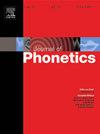Effects of sentential context on nonnative recognition of reduced speech: Does meaning explain it all?
IF 2.4
1区 文学
0 LANGUAGE & LINGUISTICS
引用次数: 0
Abstract
In casual speech, reduction of segments or even syllables is common. Native (L1) listeners recover these reduced forms by recruiting not only semantic and syntactic but also fine-grained acoustic cues in the surrounding utterance. Whether second-language (L2) listeners exploit the same constellation of cues is still poorly understood. We therefore compared 21 L1 English listeners and 21 Mandarin learners of English as they identified reduced targets (e.g., /tuɪnə/ ‘too into’) presented in one of three contexts: Isolation, Textual (orthographic context only), and Auditory (orthography plus the original carrier sentence). Accuracy patterns revealed a graded facilitation hierarchy. For L2 listeners, semantic-syntactic information alone (Textual) boosted recognition relative to Isolation, and adding acoustic context produced a further significant gain. Nevertheless, both effects were smaller for L2 than for L1 listeners, indicating less effective contextual integration in the L2 processing mechanism. The findings refine accounts of reduced-speech perception by showing that L2 listeners can harness acoustic context, but less efficiently than L1 listeners.
句子语境对非母语语音简化识别的影响:意义能解释一切吗?
在随意的讲话中,省略音段甚至音节是很常见的。母语(L1)听者不仅通过收集周围话语中的语义和句法线索,而且还通过收集细粒度的声音线索来恢复这些简化形式。第二语言(L2)的听者是否也利用了同样的线索群,我们仍然知之甚少。因此,我们比较了21名母语英语听众和21名普通话英语学习者,因为他们识别了在三种语境中出现的减少目标(例如,/tu / n / / ' too into '):孤立、文本(仅限正字法语境)和听觉(正字法加上原始载体句)。准确度模式显示了一个分级的促进层次。对于二语听者来说,单独的语义句法信息(文本信息)相对于孤立信息提高了识别能力,而添加声学上下文则产生了进一步的显著增益。然而,这两种影响对于第二语言的听者来说都比母语听者要小,这表明第二语言加工机制中的语境整合效果较差。研究结果表明,第二语言的听者可以利用声音环境,但效率不如第一语言的听者,从而完善了对言语感知减少的解释。
本文章由计算机程序翻译,如有差异,请以英文原文为准。
求助全文
约1分钟内获得全文
求助全文
来源期刊

Journal of Phonetics
Multiple-
CiteScore
3.50
自引率
26.30%
发文量
49
期刊介绍:
The Journal of Phonetics publishes papers of an experimental or theoretical nature that deal with phonetic aspects of language and linguistic communication processes. Papers dealing with technological and/or pathological topics, or papers of an interdisciplinary nature are also suitable, provided that linguistic-phonetic principles underlie the work reported. Regular articles, review articles, and letters to the editor are published. Themed issues are also published, devoted entirely to a specific subject of interest within the field of phonetics.
 求助内容:
求助内容: 应助结果提醒方式:
应助结果提醒方式:


